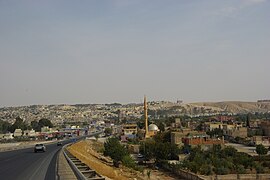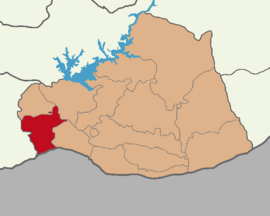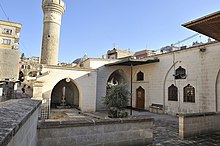Birecik
Birecik | |
|---|---|
District and municipality | |
 | |
 Map showing Birecik District in Şanlıurfa Province | |
| Coordinates: 37°01′30″N 37°58′37″E / 37.02500°N 37.97694°E | |
| Country | Turkey |
| Province | Şanlıurfa |
| Government | |
| • Mayor | Mahmut Mirkelam (AKP) |
| Area | 912 km2 (352 sq mi) |
| Elevation | 450 m (1,480 ft) |
| Population (2022)[1] | 93,613 |
| • Density | 100/km2 (270/sq mi) |
| Time zone | UTC+3 (TRT) |
| Postal code | 63400 |
| Area code | 0414 |
| Website | www |
Birecik[a] is a municipality and district of Şanlıurfa Province, Turkey.[5] Its area is 912 km2,[6] and its population is 93,613 (2022).[1] It lies on the Euphrates.
Built on a limestone cliff 400 ft. high on the left/east bank of the Euphrates, "at the upper part of a reach of that river, which runs nearly north-south, and just below a sharp bend in the stream, where it follows that course after coming from a long reach flowing more from the west".[7]
Etymology
The historical name of the town, al-Bīra in Arabic and Bīreh in Syriac, derives from the Aramaic Bīrthā, meaning fortress. It later evolved to Birecik with the addition of the Turkish diminutive suffix, cik. It is called Belejik amongst the local population.[3] In Ottoman times, the historical forms Bi'retü'l-Fırat, Biğrecik, and Biğrecek are also attested.[8]: 160
Geography

Birecik is located between Gaziantep to the west and the Urfa plateau to the east.[8]: 159
The region's elevation varies between about 400 and 500 meters above sea level, with steep slopes along the banks of the Euphrates.[8]: 159 Low-lying areas are used for farming; the higher areas are used for livestock grazing.[8]: 159 Cotton growing is common in the Birecik area.[8]: 159 There are no major tributaries of the Euphrates in the area, although there are some minor streams such as the Kerzin Çayı (located about 8 km south of Birecik), Hamomin Dere, Yedigöz Dere, and Pırpar Dere. [8]: 159
Geology

The lowest geological layer in the Birecik area is the Gaziantep Formation, which dates to Eocene through Oligocene times.[8]: 159 Large exposed outcroppings of formation this exist around Birecik and along the Euphrates.[8]: 159 It consists of gray, soft to medium-hard chalky limestone, marl, clayey limestone, and limestone.[8]: 159
The upper levels of the Gaziantep Formation contain a distinct
Above the Gaziantep Formation is a basalt formation which covers a large area between Birecik and Suruç.[8]: 160 This basalt formation was formed from basalt flows during Pliocene times.[8]: 160 By this time, the Birecik area was no longer underwater – during the Middle and Late Miocene, tectonic activity had uplifted the region above sea level.[8]: 160 Major basalt outcroppings exist at Arat Dağı, Karadağ, and north of Suruç.[8]: 160 To a lesser extent, there are also outcroppings west of the Euphrates.[8]: 160
Most of the underlying basalt and limestone formations are now covered by more recent alluvial deposits.[8]: 159 There is also an alluvial plain along the Euphrates, formed by clay, sand, silt, and gravel deposited during floods.[8]: 160 This area is about 3 km wide around Birecik but only 1 km wide further north near ancient Zeugma.[8]: 160 To the west of the Euphrates, there are also fluvial terraces.[8]: 160
Climate
Birecik has a semi-arid climate (Köppen: BSh).[9] The average annual temperature in Birecik is 18.2 °C (64.8 °F), and average annual precipitation is 354 millimetres (13.9 in).[10]
| Climate data for Birecik (1991–2020) | |||||||||||||
|---|---|---|---|---|---|---|---|---|---|---|---|---|---|
| Month | Jan | Feb | Mar | Apr | May | Jun | Jul | Aug | Sep | Oct | Nov | Dec | Year |
| Mean daily maximum °C (°F) | 11.5 (52.7) |
13.6 (56.5) |
18.5 (65.3) |
24.0 (75.2) |
30.5 (86.9) |
36.7 (98.1) |
40.6 (105.1) |
40.1 (104.2) |
35.3 (95.5) |
28.6 (83.5) |
19.7 (67.5) |
13.3 (55.9) |
26.1 (79.0) |
| Daily mean °C (°F) | 6.2 (43.2) |
7.5 (45.5) |
11.6 (52.9) |
16.3 (61.3) |
22.1 (71.8) |
27.9 (82.2) |
31.4 (88.5) |
30.5 (86.9) |
25.5 (77.9) |
19.4 (66.9) |
11.9 (53.4) |
7.6 (45.7) |
18.2 (64.8) |
| Mean daily minimum °C (°F) | 1.9 (35.4) |
2.6 (36.7) |
5.2 (41.4) |
9.0 (48.2) |
13.4 (56.1) |
18.2 (64.8) |
21.2 (70.2) |
20.4 (68.7) |
15.6 (60.1) |
11.4 (52.5) |
5.9 (42.6) |
3.2 (37.8) |
10.7 (51.3) |
| Average precipitation mm (inches) | 60.52 (2.38) |
53.77 (2.12) |
44.54 (1.75) |
38.9 (1.53) |
23.05 (0.91) |
6.4 (0.25) |
0.37 (0.01) |
0.96 (0.04) |
2.7 (0.11) |
20.52 (0.81) |
42.86 (1.69) |
59.87 (2.36) |
354.46 (13.96) |
| Average precipitation days (≥ 1.0 mm) | 7.5 | 7.5 | 6.9 | 5.5 | 3.9 | 1.6 | 1.0 | 1.1 | 1.6 | 3.3 | 5.2 | 7.1 | 52.2 |
| Average relative humidity (%)
|
71.4 | 68.0 | 62.6 | 58.5 | 51.1 | 42.6 | 41.7 | 44.7 | 48.0 | 55.6 | 66.6 | 72.6 | 56.8 |
| Source: NOAA[10] | |||||||||||||
Archaeology
The cemetery was used between 3100-2600 BC.[11]
Early archaeological inspection in the Birecik area was done in 1894 by J.E. Gauiter.[12]: 54 Later, in 1946, K. Kökten conducted a survey of the area and found traces of Middle Paleolithic occupation.[12]: 54 Another survey was done in 1989 by a team headed by G. Algaze.[12]: 54 Among the sites first identified by the Algaze survey were Akarçay Tepe and Mezraa Teleilat, which are two of the oldest known settlements in the Euphrates basin.[12]: 56, 58–9 In 1998, with the pending construction of a dam, excavations were done on sites that would be inundated once the dam was completed.[12]: 54 More Middle Paleolithic findings were encountered by a team headed by M. Özdoğan and N. Karul in 2001.[12]: 54
History
Antiquity
The 1911 Encyclopædia Britannica identified Birecik with ancient
The placing of Apamea-Zeugma further upstream and the identification of Birecik with Roman Birtha was already stated in the American Journal of Archaeology in 1917;
The name "Birtha" is found in no ancient Greek or Roman writer, although Bithra (
The Greeks at one stage called what is now Birecik by the name Macedonopolis (anglicized also as Makedonoupolis). The city represented by bishops at the First Council of Nicaea and the Council of Chalcedon is called by this name in Latin and Greek records, but Birtha in Syriac texts. A 6 AD inscription in Syriac found at Birecik contains an epitaph of Zarbian, "commander of Birtha".[16][19][20]
Ancient Birtha grew when the ancient city of Carchemish (known as Europos to the Greeks) became abandoned; this had happened by the middle of the 4th century.[21]: 198 Another possible impetus for Birtha's growth was when the Romans withdrew their legion from Zeugma after a Persian attack in the mid-3rd century; some of Zeugma's inhabitants may have moved to Birtha at that point.[21]: 198–9 Although Birtha served as a crossing point on the Euphrates, the main crossing was still at Zeugma.[21]: 198


Medieval History
The town maintained its importance during medieval times as it protected the most important crossing of the Euphrates in northern Syria.[22] The crossing at Zeugma was no longer used, and the traffic all went to Birecik instead.[21]: 208 Zeugma's population had probably also moved to Birecik as well.[21]: 208 Al-bira had been under control by the Muslim Arabs from 637 until 1079 when it was conquered by the Seljuk Turk warlord Tutush but at some point afterwards it was taken by the Armenians.[23] When the First Crusade arrived in the region, the town was under control of the Armenian Ablgharib, who was a vassal to the Armenian ruler Kogh Vasil.[24] Matthew of Edessa states that the army of Ablgharib numbered 1,000 and that he was eventually removed by the Franks.[25] Matthew's account of this is suspect however as it seems that his daughter married the next lord, Galeran of Le Puiset of the Montlhery family, and it seems that Ablgharib's position was preserved to a certain extent.[22] Birecik then formed part of the County of Edessa; it was strongly fortified with a castle and served as the capital of a minor feudal lordship.[21]: 208
In 1151, Birecik was captured by the
Birecik was later captured by the
In 1401, however,
Ottoman History
| 1520 | 1536 | 1552 | 1570 |
|---|---|---|---|
| 75,000 | 180,000 | 180,000 | 200,000 |

Birecik became part of the Ottoman Empire in 1516.[26] It already had a dock at the time that was collecting tolls; the income from the tolls rose dramatically after Suleiman the Magnificent's campaign to conquer Baghdad in 1534 (see table).[26]
Meanwhile, by 1547 the Ottomans had chosen to make Birecik the site of a major imperial shipyard – the empire's first in Mesopotamia.
The first reference to the Ottoman shipyard at Birecik is in June 1547, when an Arab merchant from Basra named Hajji Fayat reported to the Portuguese governor in
In 1559, the Ottomans decided to deploy five new
Modern history
Birecik was the scene of an unusually cruel massacre and persecution of Armenians in 1895.[13]
Composition
There are 83
- Abdallı
- Akarçay
- Akpınar
- Almaşar
- Altınova
- Arslanlı
- Aşağı Eşme
- Aşağı Fatmacık
- Aşağı Habib
- Aşağı Karkutlu
- Aşağı Kuyucak
- Aşağıalmaşar
- Ayran
- Bağlarbaşı
- Bahçeönü
- Bentbahçesi
- Böğürtlen
- Bozdere
- Boztepe
- Cibinören
- Çiçekalan
- Çiftlikköy
- Çoğan
- Cumhuriyet
- Dağgören
- Dalocak
- Damlıca
- Diktepe
- Dışlık
- Divriği
- Dorucak
- Duyduk
- Düzlüce
- Ekenek
- Geçittepe
- Göktepe
- Günışığı
- Güvenir
- Güzelyurt
- Han
- Haydarahmet
- Hocaşerif
- Ilgar
- İnceler
- İncirli
- İncirlidere
- İnnaplı
- Karababa
- Karşıyaka
- Keskince
- Kocaali
- Kömağıl
- Konakköy
- Kural
- Kurtuluş
- Kurucahöyük
- Mengelli
- Merkez
- Meteler
- Meyanca
- Meydan
- Mezra
- Ortafatmacık
- Özveren
- Saha
- Sancak
- Şekerköy
- Sekili
- Söğürtlen
- Sumaklı
- Surtepe
- Tüten
- Uğurcuk
- Ünsal
- Yaylacık
- Yeniakpınar
- Yılmaz
- Yukarı Incirli
- Yukarı Karabaş
- Yukarıhabib
- Yukarıyeniçağ
- Yuvacık
- Ziyaret
Demographics
In mid-19th century, Swiss traveler Alexander Schläfli recorded that Birejik had 5500-6000 people with 50-60 Armenian families and the rest being Turks. He further mentioned that Birejik was an ethnic and linguistic border, because to the east lived Kurdish tribes, to the west Turks-Turkmens, and to the south Arab tribes.[29] In his travels, Julius Heinrich Petermann observed that the north and northeastern sides of the town were inhabited by Kurds, who partly lived in rock caves, while further south lived Turks and some Armenians.[30]
Architecture

Historically, Birecik's urban fabric was made up of stone houses.[8]: 162 The stone used in these houses was mostly derived from two sources.[8]: 162 The first is limestone quarried from Kalazan Dağı, northwest of the city.[8]: 162 This stone, which was also used to build other historical buildings in Birecik, is derived from the upper limestone member of the Gaziantep Formation and is resistant to weathering.[8]: 162 Four old quarries at Kalazan Dağı have been identified.[8]: 162 The other type main type, used particularly in later times, is the marly limestone known as havara coming from a quarry east of Birecik.[8]: 162–3 This type is less resistant to weathering.[8]: 162 In some buildings, both types of stone were used.[8]: 162 More recently, Urfa limestone has also been used in restoration work on historic buildings.[8]: 162 One example is the Mahmutpaşa Cami, which now has examples of all three types of stone.[8]: 162
Qanat
An old qanat, estimated to be 30 km long, historically brought water to Bireck for drinking, irrigation, water mills, and other uses.[8]: 162 The exact source of the water is not known – locals believe it comes from Arat Dağı, but a survey by Gürpinar et al was unable to verify this.[8]: 162 Gürpinar et al guessed that the ultimate source for the water is the karstic reservoir in the limestone member of the Gaziantep Formation.[8]: 162
The main tunnel of the qanat is about 1.5 m in diameter and about 2-10 m below the surface.[8]: 162 Its course is dug in a thick and relatively soft layer of rock that forms part of the Gaziantep Formation, and it stands without supports.[8]: 162 Vertical wells were dug at several points along the qanat's course so they could access the water.[8]: 162 Water flows through the qanat at a rate of approximately 20 liters per second.[8]: 162
Castle
Birecik Castle (in Turkish: Birecik Kalesi) is built on a clayey limestone hill that belongs to the Gaziantep Formation.[8]: 162 Rockfall caused by erosion of the hill has happened in some areas.[8]: 162 The castle itself is built out of limestone quarried from Kalazan Dağı to the northwest.[8]: 162
Bishopric
As an
The names of three of its bishops are recorded in extant documents. Mareas signed the acts of the First Council of Nicaea in 325 as bishop of Macedonopolis, The chronicle of
No longer a residential bishopric, Birtha is today listed by the Catholic Church as a titular see.[33]
Gallery
See also
Notes
References
- ^ TÜİK. Retrieved 19 September 2023.
- ^ Minasyan, Mihran. "Antep-Fotoğrafçılar". houshamadyan. Retrieved 1 December 2021.
- ^ a b Streck, M.; Parry, V.J. "Bīred̲j̲ik". Encyclopaedia of Islam, Second Edition. Brill Publishers. Retrieved 17 December 2022.
- ISBN 9786054296002.
- ^ Büyükşehir İlçe Belediyesi, Turkey Civil Administration Departments Inventory. Retrieved 19 September 2023.
- ^ "İl ve İlçe Yüz ölçümleri". General Directorate of Mapping. Retrieved 19 September 2023.
- ^ a b c d William Smith, Dictionary of Greek and Roman Geography (1854)
- ^ . Retrieved 18 February 2023.
- ^ "Table 1 Overview of the Köppen-Geiger climate classes including the defining criteria". Nature: Scientific Data.
- ^ a b "World Meteorological Organization Climate Normals for 1991-2020 — Birecik". National Oceanic and Atmospheric Administration. Retrieved January 13, 2024.
- ^ Sertok, K. and Ergeç, R. 1999. A New Early Bronze Age Cemetery: Excavation near the Birecik Dam, Southeastern Turkey. Preliminary Report (1997-98) Anatolica 25: 87-107
- ^ ISBN 978-975-585-992-7. Retrieved 8 November 2022.
- ^ a b c d e One or more of the preceding sentences incorporates text from a publication now in the public domain: Chisholm, Hugh, ed. (1911). "Birejik". Encyclopædia Britannica. Vol. 3 (11th ed.). Cambridge University Press. p. 979.
- ^ One or more of the preceding sentences incorporates text from a publication now in the public domain: Chisholm, Hugh, ed. (1911). "Seleucia". Encyclopædia Britannica. Vol. 24 (11th ed.). Cambridge University Press. p. 603.
- ISBN 978-1-13619271-5), p. 41, footnote
- ^ ISBN 978-1-13619271-5), p. 165, footnote
- ^ American Journal of Archaeology, 1917, p. 453
- ISBN 978-0-67448882-3), p. 112
- ISBN 978-0-52095356-7), pp. 81–82
- ^ a b G. Levencq, v. Birtha in Dictionnaire d'Histoire et de Géographie ecclésiastiques, vol. VIII, Paris 1935, coll. 1538-1539
- ^ ISBN 0-907132-52-9. Retrieved 20 March 2022.
- ^ a b MacEvitt 2010, pp. 88.
- ^ Morton 2020, p. 82.
- ^ Morton 2020, p. 83.
- ^ Morton 2020, pp. 84.
- ^ ISBN 978-0-19-754729-8. Retrieved 19 March 2022.
- ^ "Turkey". Archived from the original on 2008-09-10. Retrieved 2006-05-13.
- ^ Mahalle, Turkey Civil Administration Departments Inventory. Retrieved 19 September 2023.
- ^ Schläfli, Alexander (1864). Reisen in den Orient (in German). J. Wurster & Comp. p. 19. Retrieved 5 December 2022.
Biredschik besitzt 1200-1250 Häuser mit 5500-6000 Einwohner, worunter 50-60 armenische Familien, die andern sind Türken. Es bildet hier eine Sprach- und Völkergrenze, denn südwarts von Biredschik beginnen die arabischen, ostwärts die kurdischen Stämme, westwärts herrschen Türken vermischt mit Türkmen.
- ^ Petermann, Julius Heinrich (1860). Reisen im Orient (in German). Veit & Comp. p. 18. Retrieved 5 December 2022.
An der Nord- und Nordostseite der Stadt wohnen die Kurden, zum Theil als wahre Troglodyten in Felsenhöhlen, weiter nach Süden die Türken und wenige Armenier.
- ^ Siméon Vailhé in Échos d'Orient 1907, p. 94 and p. 145
- ^ a b Louis Petit, "Birtha" in Catholic Encyclopedia (New York 1907)
- ISBN 978-88-209-9070-1), p. 850
- Sources
- MacEvitt, Christopher (2010). The Crusades and the Christian World of the East: Rough Tolerance. University of Pennsylvania Press. ISBN 9780812202694.
- Morton, Nicholas (April 2020). The Crusader States and their Neighbours: A Military History, 1099-1187. Oxford University Press. ISBN 9780192557988.









